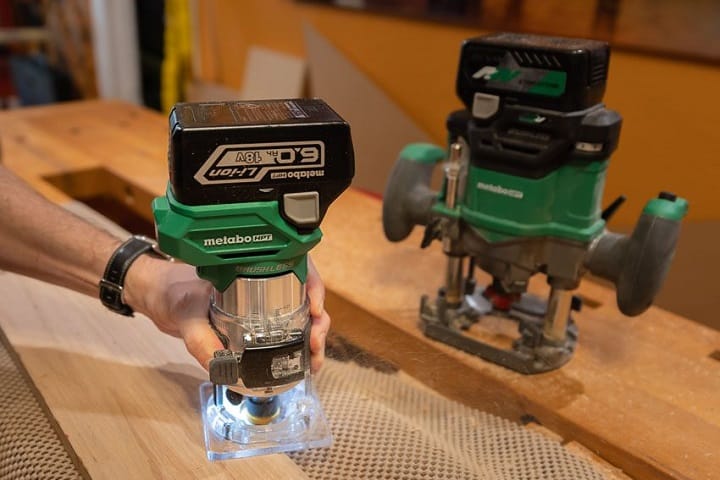I love creating free content full of tips for my readers, you. I don't accept paid sponsorships, my opinion is my own, but if you find my recommendations helpful and you end up buying something you like through one of my links, I could earn a commission at no extra cost to you. Learn more
For crafters or woodworkers, the router is the most versatile and handy tool available today. They are generally used to furnish plastic sheets, veneer, hardboard, wooden and metallic workpieces.
Crafters also utilize them for a number of activities, including polishing wood, plastic, or metal surfaces, cutting rabbits, flooring, trimming hardwood, and drilling. Routers are quite popular among crafters, and if you do a little research, you will discover a plethora of routers in all shapes and sizes for various applications including regular router, trim router, plunge router, palm router, and many more.

In this post we'll cover:
What Is A Router
A router, also known as a standard router, is a large, stationary power instrument that allows you to cut a workpiece into any desired form, such as a circle, sphere, square, and so on. You can also use this router to route out entrances through existing walls, cut perfect dadoes, and make the most beautiful wood designs. An electric motor, a rotor blade, two arms, and a controlling lever make up a router. The router’s exterior casing is constructed of metal, plastic, and rubber, and it protects all of the router’s electric components. Each side of the metal body of a standard router contains spring-loaded arms and you will be able to cut the workpiece by shifting the machine up and down on the base by holding those arms.Features Of A Router
Generally, all routers have a metal body with two soft grip rubber handles on the frame construction. It features a continuous response mechanism, which enables the router to maintain a steady speed during operation. As a consequence, you will be able to produce a smoother and more accurate product. It also has a number of distinctive features, such as:- Material: Made of metal, plastic, and rubber.
- Components: Consists of a motor, a blade, two arms, and a regulating lever.
- Product Dimensions: Almost every router has a dimension of 36.5 x 28.5 x 16 cm.
- Product Weight: Routers are lightweight, weighing around 5 kg 150 g.
- Components Supplied: A normal router with a screwdriver, templates manual, dust adapter, and two or three drill bits.
- It consumes 1300W (watt) power and uses a power cable that connects to the main power grid.
Usage Of Router
The router is mostly used in woodworking. You can also use a router for a wide range of tasks. For example:- It’s also used to cover door hinges.
- You can cut dadoes easily using it.
- You can use these routers to shape stylish molding.
- Carved-out clean rabbets will be smoother if you use this router.
- You can use it to duplicate preexisting workpieces or wooden patterns.
Advantage And Disadvantages Of A Router
We will discuss the benefits and drawbacks of routers in this section of the article. From this comparison, you will be able to find out whether the router is suitable for your project or not.Advantages Of Routers
- Router or standard router is more powerful than other router types.
- You can use different bits or blades on the same machine.
- Routers are durable and easy to use.
- It has a higher RPM rate, which implies that entry will be smooth.
- You can use the router to perform heavy tasks including cutting rabbits, flooring, cleaning hardwood, deep throating, and drilling holes.
Disadvantages Of Routers
- It uses more electricity than a trim router.
- You must operate a router within a specific radius of the power socket because the router is not portable and is powered by a power wire from the main grid.
- Standard routers are insufficient for smaller projects such as jewelry making, modest electrical projects, and house renovations.
What Is A Trim Router
A trim router is a tiny, handheld woodworking gadget that’s typically used to make decorative borders and holes in a workpiece like photo frames and window casings. It’s a more compact and portable version of a regular router or a standard router. It was developed in 1998, and it captured the hearts of artisans and earned a place in every craftsman’s toolbox within two decades.
Features Of A Trim Router
A trim router is made of Aluminum, a little bit of plastic, and rubber. It includes an electric motor, blade, and a pilot bearing mechanism. It also has a disc lock to make replacing the bit easier, as well as a quick access adjustment mechanism for precise depth control. In this section of the post, I’ll go over some of the extra features that make the trim router so popular.- Material: Made of metal, plastic, and rubber.
- Product Weight: It weighs around 4 pounds.
- Trim router Dimensions: Approximately 6.5 x 3 x 3 inches.
- It comes with a quick-release lever that makes removing the engine from the base a breeze.
- Load Speeds: Its load speed ranges between 20,000 and 30,000 r/min (round per minute)
Usage Of Trim Router
- A trim router is best for working on small projects like jewelry making, small gadget design, furniture making, and home renovation.
- It’s the best for smoothing off the edges.
- You can use it to laminate the edge of your workpiece.
Advantage And Disadvantages Of Trim Router
Like all other electronic gadget trim, a router also has some benefits and drawbacks. We will briefly explore them in this portion of the article.Advantages Of Trim Routers
- You can use a trim router one-handedly.
- You can create a perfect hinge using a trim router.
- The Trim router is compact and makes it a very handy tool.
- The biggest advantage of utilizing a trim router is that it can be used to decorate and furnish wooden or plastic surfaces without harming them.
Disadvantages Of Trim Routers
- Trim routers are not suitable for heavy-duty tasks.
- You must work within a specified range of the power socket because the trim router is not portable and is powered by a power cable from the main grid.
Similarities And Difference Between Trim Router Vs Router
Similarities
- Designed for efficiency, they will get the job done quickly in the hands of skilled craftsmen.
- The main similarity between router and trim router is that they are both amazing for carving, edging, reshaping, and trimming.
Difference
- Trim routers are excellent for little projects, whereas routers are better for larger jobs or heavy-duty projects.
- Trim routers are more handy and lightweight compared to a standard router.
- The power output of a trim router can be less than that of a regular router.
Frequently Asked Questions (FAQ)
Q: Is it possible to use a regular router instead of a trim router? Answer: No, it is not possible. You can not use a regular router instead of a trim router because normal routers are made for heavy-duty work and trim routers are designed for tiny and fancy tasks. Your workpiece will be damaged if you use your router instead of a trim router, and it may even hurt you. Q: Which router should I use? Answer: It entirely depends on what kind of project you have. If you’re working on a heavy-duty project, I recommend getting a regular router, and if you’re working on a fancy project, get a trim router.Conclusion
Routers are known as the crafter’s third hand. They are quite handy and save you a great deal of time when compared to physical labor. If you are a crafter or going to start a crafting job a router should be in your toolbox. However, you should thoroughly understand the router before purchasing or using it; else, it may disappoint you. In this post, I have included all you need to know about the router for your convenience. Be sure to read it before purchasing.I'm Joost Nusselder, the founder of Tools Doctor, content marketer, and dad. I love trying out new equipment, and together with my team I've been creating in-depth blog articles since 2016 to help loyal readers with tools & crafting tips.
